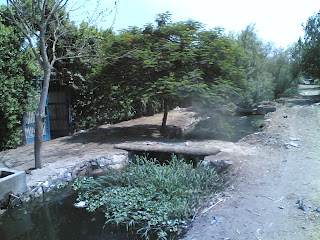
To the untrained eye, water hyacinth is very pretty. Its big round leaves give way to lovely pale violet flowers that look for all the world like the hyacinths that used to bloom early in spring in my garden in Canada. They don't have the lovely scent as far as I know, but then leaning over a canal to smell a flower isn't the best idea at the best of times. Most of the canals here have the plant growing in them and periodically they are dragged out and left at the sides of the canals for wandering goats and sheep to eat. Besides being pretty, I've been told that the plant also takes up heavy metals in the water, which probably doesn't make it the best animal feed in the world. To be honest, the goats seem to only nibble on the freshest leaves and then only if there isn't anything better to be had.

The downside of water hyacinth is that a lot of water is lost to evaporation from the leaves and it clogs the channels of the canals so that the water doesn't flow freely. Beautiful or not, it is a weed. This morning I found an odd little item from the Shanhai Daily, a newspaper in China (bless Google News) that talks about a Chinese company coming to Egypt to manufacture furniture from the water hyacinth that grows in our canals. Apparently the weed itself is of superior quality in Egypt and the labour costs are low enough to make the investment a good thing. I must confess to being a bit stunned at the idea that a Chinese company thought that Egypt would be a nice cheap place to manufacture something. My second thought was to hope that someone puts some environmental safeguards on such a factory, not that Egypt is notoriously strict in that department, but China appears to be much worse. According to the article the manufacture of water hyacinth board does not involve the formaldehyde and other toxic chemicals that fiber board and plywood do. I'd want to do a bit more research before I take anyone's word on that, but if true, this all sounds terrific. We get rid of our weeds and have a new supply of wood for building furniture. One of the problems for furniture makers here is the fact that we have to import all of the wood, since we have no forests. It all sounds, on the surface, like a nice fit. Now let's hope the reality lives up to the press...but that's always the problem, isn't it?
copyright 2007 Maryanne Stroud Gabbani